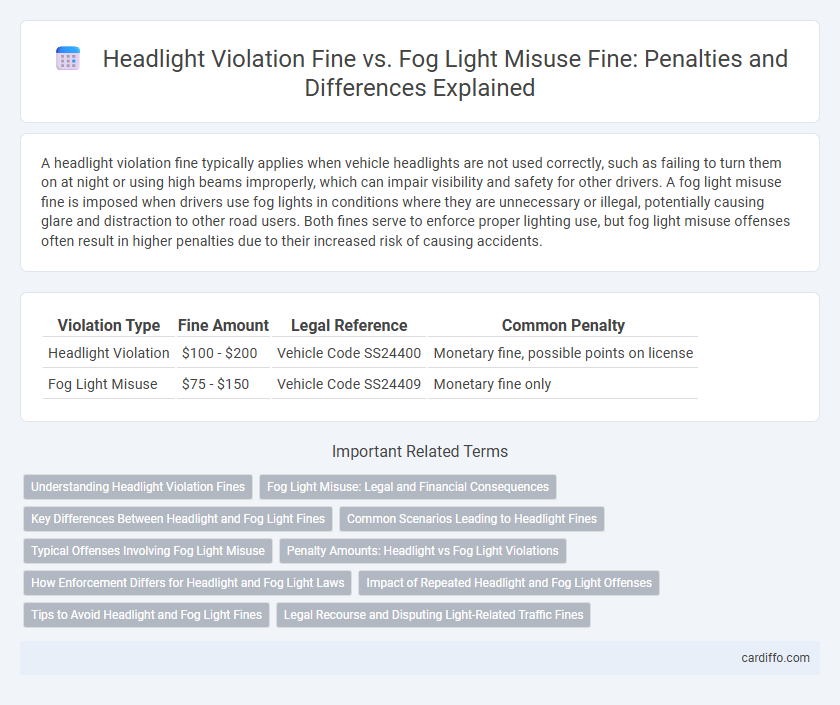A headlight violation fine typically applies when vehicle headlights are not used correctly, such as failing to turn them on at night or using high beams improperly, which can impair visibility and safety for other drivers. A fog light misuse fine is imposed when drivers use fog lights in conditions where they are unnecessary or illegal, potentially causing glare and distraction to other road users. Both fines serve to enforce proper lighting use, but fog light misuse offenses often result in higher penalties due to their increased risk of causing accidents.
Table of Comparison
| Violation Type | Fine Amount | Legal Reference | Common Penalty |
|---|---|---|---|
| Headlight Violation | $100 - $200 | Vehicle Code SS24400 | Monetary fine, possible points on license |
| Fog Light Misuse | $75 - $150 | Vehicle Code SS24409 | Monetary fine only |
Understanding Headlight Violation Fines
Headlight violation fines typically incur higher penalties compared to fog light misuse due to safety concerns related to impaired visibility at night. Regulations specify correct headlight usage, and violations such as driving without headlights after dark or using high beams improperly result in substantial fines. Understanding these fines helps drivers comply with traffic laws and avoid costly penalties linked to headlight misuse.
Fog Light Misuse: Legal and Financial Consequences
Fog light misuse can lead to significant legal and financial consequences, with fines often exceeding those for headlight violations due to increased risks of visibility impairment and traffic accidents. Enforcement agencies impose penalties ranging from monetary fines to points on the driver's license, and repeated offenses may escalate to license suspension or higher court penalties. Understanding specific local laws on fog light usage is essential to avoid these costly repercussions and ensure road safety compliance.
Key Differences Between Headlight and Fog Light Fines
Headlight violation fines typically incur higher penalties due to their critical role in visibility and road safety, while fog light misuse fines are generally lower but still enforced to prevent glare and distraction. Headlight fines focus on violations like failing to use headlights at night or during poor visibility, whereas fog light fines often address improper use of fog lamps in clear conditions. Law enforcement prioritizes headlight compliance to reduce accidents, making those fines more common compared to fog light misuse penalties.
Common Scenarios Leading to Headlight Fines
Common scenarios leading to headlight violation fines include failing to use headlights during low visibility conditions such as dusk, dawn, rain, or fog, and neglecting to switch on headlights when entering tunnels or nighttime zones. Another frequent cause is using high beams improperly, such as dazzling oncoming traffic or failing to switch to low beams when approaching other vehicles. Many drivers are also fined for broken or non-functioning headlights, which compromise road safety and violate vehicle equipment regulations.
Typical Offenses Involving Fog Light Misuse
Typical offenses involving fog light misuse include using fog lights in clear weather, which can dazzle other drivers and lead to safety hazards, often resulting in fines comparable to or exceeding headlight violation penalties. Fog light misuse fines may vary by jurisdiction but generally emphasize improper illumination levels and incorrect light placements. In contrast, headlight violation fines typically focus on non-functional or improperly aimed headlights, highlighting enforcement differences based on specific lighting regulations.
Penalty Amounts: Headlight vs Fog Light Violations
Headlight violation fines typically range from $100 to $200, reflecting the safety risk posed by improper use or failure to use headlights during required times. Fog light misuse fines are generally lower, often between $50 and $100, due to their limited impact on visibility compared to headlights. Enforcement agencies prioritize penalties on headlight violations due to their critical role in night driving safety.
How Enforcement Differs for Headlight and Fog Light Laws
Enforcement of headlight violation fines typically involves strict regulation due to their critical role in road safety during nighttime and low-visibility conditions, with penalties often more severe considering the higher risk of accidents. Fog light misuse fines, however, are enforced less rigorously and primarily target improper usage such as using fog lights in clear weather or during daytime, where they can cause glare and distraction to other drivers. Law enforcement agencies use vehicle inspections and dashcam footage to identify headlight infractions, while fog light violations rely more on situational assessments and driver behavior observations.
Impact of Repeated Headlight and Fog Light Offenses
Repeated headlight violations typically result in higher fines and increased points on the driver's license compared to fog light misuse due to safety risks associated with improper lighting during night driving. Multiple offenses of headlight violations can lead to stricter penalties such as license suspension, while repeated fog light misuse fines are generally lower but may escalate if misuse compromises visibility. Consistent enforcement of these regulations aims to reduce accidents caused by improper vehicle lighting and promote safer road conditions.
Tips to Avoid Headlight and Fog Light Fines
Maintain proper headlight alignment and ensure all bulbs are functioning to avoid headlight violation fines. Use fog lights only in low visibility conditions like fog, heavy rain, or snow to prevent misuse penalties. Regular vehicle inspections and understanding local traffic laws help drivers comply with lighting regulations and steer clear of fines.
Legal Recourse and Disputing Light-Related Traffic Fines
Disputing a headlight violation fine typically involves demonstrating adequate light functionality or compliance with state-specific lighting standards, whereas contesting a fog light misuse fine often requires proving correct usage under low-visibility conditions as defined by local traffic laws. Legal recourse may include presenting evidence such as photographs, repair receipts, or expert testimony to challenge the basis of the citation. Understanding jurisdictional regulations and consulting with traffic violation attorneys can significantly increase the chances of successfully overturning light-related traffic fines.
Headlight violation fine vs Fog light misuse fine Infographic

 cardiffo.com
cardiffo.com